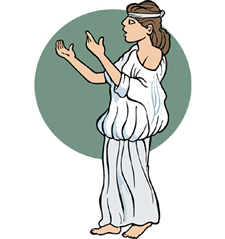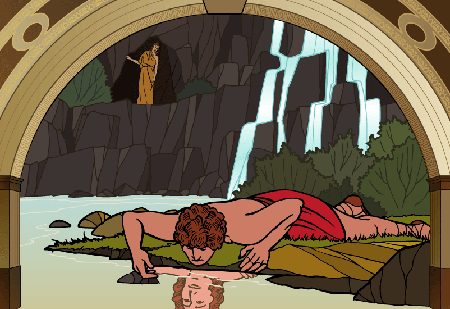Lesson 4.1A: Original Story Telling
 There was a time, a long, long time ago, when stories were told by the light of the fire or when the moon had risen clear and full in the sky, and when a community of people was done with the day's work. This was a time when people did not know what a book was and certainly could not even imagine a computer. The early people simply told their stories. One person talked and the others all listened very attentively. Likely, stories of the day's adventures were shared - dangerous encounters with wild animals and silly pranks between family members may have been the topics of the original stories. We can never know when the first story was told or by whom, but what we can know is that even before writing was invented, story-telling was a crucial part of human life. There was a time, a long, long time ago, when stories were told by the light of the fire or when the moon had risen clear and full in the sky, and when a community of people was done with the day's work. This was a time when people did not know what a book was and certainly could not even imagine a computer. The early people simply told their stories. One person talked and the others all listened very attentively. Likely, stories of the day's adventures were shared - dangerous encounters with wild animals and silly pranks between family members may have been the topics of the original stories. We can never know when the first story was told or by whom, but what we can know is that even before writing was invented, story-telling was a crucial part of human life.
Passed down from father to son, mother to daughter, an oral tradition of story telling would have kept alive the customs and beliefs of a group from generation to generation.
Today, stories are everywhere. Music, television, books, magazines, movies, and the World Wide Web are all filled with stories. Even if your TV, computer, and radio were turned off, your friend might tell you what happened at work, or your parents might tease you with a story of what you were like as a child. We cannot escape the influence of stories.
In this lesson, you will experience two kinds of traditional stories first hand: a Greek myth and an Aboriginal story. Both of these traditions have their roots in oral storytelling.
 Once Upon a Myth Once Upon a Myth
Once upon a time, when you were a small child still very much attached to your parents, you would have found the bedtime story book one of the most comforting parts of your day. Curled up close to your loved ones, you would have eagerly listened to tales of fantasy, love, and adventure with your eyes wide and your mind alight.
Much like those first stories of your youth, the first stories of humans often focused on a single hero whose adventures taught a valuable lesson about life.
One type of first story is a myth. A myth is a traditional story that comes from an older culture, often a culture that does not communicate primarily through reading and writing. The purpose of myths or stories to these cultures was to explain many aspects of life that were hard to understand, such as origins of the world and the people and animals within it.
Myths may serve to explain:
- early history: how humans and animals came to be
- natural phenomena: thunder, lightening, earthquakes
- human behaviour: love, anger, jealousy
These myths, or traditional stories, began as an oral tradition. The story was told aloud by a single storyteller to an audience that would have imagined the characters and events described in their mind's eye. Gestures, costume, and perhaps even dance and music, would have been a part of the telling of the story. Then, thousands of variations of that story would have been told to thousands of audiences time and time again. For this reason, no two tellings of an oral story are exactly the same. Across cultures and continents the types of stories and myths varied, but one thing remained the same - through stories, people came to understand themselves and the world around them better.
Greek Mythology- "The Greek Miracle"
If mythology is supposed to give us insight into the way the "ancient" people of the past thought, it may come as a bit of a surprise to know that the most famous ancient myths, the Greek myths from over three thousand years ago, reveal a society that was anything but primitive. The myths from this time reveal a culture of poets and artists, and a thoughtful society. This is why the Greek myths are often referred to as "The Greek Miracle." The first written record of Greek mythology is the epic poem, The Iliad, by the poet Homer. This long tale of adventure, war, and heroes reveals a highly civilized society and a remarkably beautiful and powerful use of language.
Some attributes common to Greek myths include:
- many stories about "gods" of varying powers and shapes, but who possessed human characteristics and shortcomings, like anger, jealousy, and pride
- an emphasis on heroes, action, and the overcoming of obstacles
- a clear plot structure, with a marked beginning, middle, and end
- a moral, or lesson, to be learned about life
Not all myths possess all of these attributes; however, if you read many myths, you'll begin to notice many of these attributes repeat themselves.

Here is a sampling of some of the most famous Greek gods:
Zeus: Lord of the sky, he yielded the thunderbolt. However, he is also represented as falling in love with one woman after another.
Poseidon: Ruler of the sea, he was also commonly called the "Earth-Shaker" because he frequently upset the peaceful seas.
Aphrodite: The goddess of love and beauty. It was said that there was no joy nor loveliness anywhere without her. But she was also often portrayed as mean and malicious, exerting a destructive power.
Journal
As part of your English 10 course, you will keep a journal that will be submitted with each section assignment. You will continue using your Journal from the previous module. Turn to the appendix at the end of this module to review the Journal description, instructions, and assessment criteria.
You will submit your Journal to your teacher at the end of each section. You must submit work of good quality to earn full marks. Do not wait until the last minute to scribble down a few quick ideas.

Make certain that your entries represent your very best ideas and writing.
Journal Entry 4.1A: Modern Stories
In your Journal, respond to one of the following topics. Your response may be personal, factual, or both.
- Stories, told or written, are valuable because they share the values that shapes a culture or people. What historical myths are you familiar with? How have those myths helped you to understand a particular culture?
- What do modern stories you read or see on TV teach you about the values of our culture today? Does our culture have anything in common with the Ancient Greeks or other ancient cultures? You may find it surprising to know that many modern movies parallel the Greek hero quests. For example, both the Star Wars series and The Matrix Trilogy base their plots on old Greek tales.
|
Now let's take a moment to experience a Greek myth first hand. Have you ever heard of the term, "a narcissist"? It refers to someone who loves him or herself above all else - people who are narcissists are so absorbed by their own perceived beauty, that they do not look at anyone else with love. People who look at themselves in the mirror all the time are also often referred to as narcissists.
The word narcissist comes from the story of the Greek god Narcissus, the beautiful son of the river God Cephissus and the nymph Leirope. When he spied his reflection in the water of a spring one day, he fell in love with himself, could not look away and died. The Greek myth of Echo and Narcissus has a clear lesson for its readers: see if you can figure it out.
 Go to The Myth of Narcissus to listen to this myth. While you are listening, imagine you are a Greek citizen, three thousand years ago, gathered with some friends in a shady spot under an olive tree to listen to a story. The images will help you to recreate the time period. Enjoy! And remember to listen with a purpose: for the lesson about how to live life. Go to The Myth of Narcissus to listen to this myth. While you are listening, imagine you are a Greek citizen, three thousand years ago, gathered with some friends in a shady spot under an olive tree to listen to a story. The images will help you to recreate the time period. Enjoy! And remember to listen with a purpose: for the lesson about how to live life.
The Great Circles - An Aboriginal Tradition
Like the culture of ancient Greece, the North American Aboriginal tradition is rich with myths or narratives that explain human origins and natural phenomena. Where the Greek myths focused often on telling stories about the gods, many of the original Aboriginal myths and narratives have a different focus and structure.
Some attributes of traditional tribal (for example, Aboriginal) myths or narratives may include:
- a greater focus on nature, less on human-like gods
- an absence of a specific hero and an emphasis on the greater community
- a plot structure that moves from event to event with no clear timeline
- a plot structure that may be circular: without clear beginnings, middles, and ends
- less clear good and bad: the end of the story is often inconclusive
- there may be a lesson to be learned from the story
 Take a moment now and listen to The Mole, an Aboriginal myth. Listen carefully to see if you can figure out how the story is characteristic of traditional tribal stories. The story is told in the vernacular, using the everyday language of the storyteller: phrases like, "on account a" give the story an informal tone. Repetition is also used frequently - phrases and ideas are repeated so that you could start listening to the story at any point and easily follow along. Take a moment now and listen to The Mole, an Aboriginal myth. Listen carefully to see if you can figure out how the story is characteristic of traditional tribal stories. The story is told in the vernacular, using the everyday language of the storyteller: phrases like, "on account a" give the story an informal tone. Repetition is also used frequently - phrases and ideas are repeated so that you could start listening to the story at any point and easily follow along.

Summary
Completing this lesson has helped you to:
- understand some of the history of oral storytelling
- consider the differences in story telling across cultures
- define myths and narratives
|

